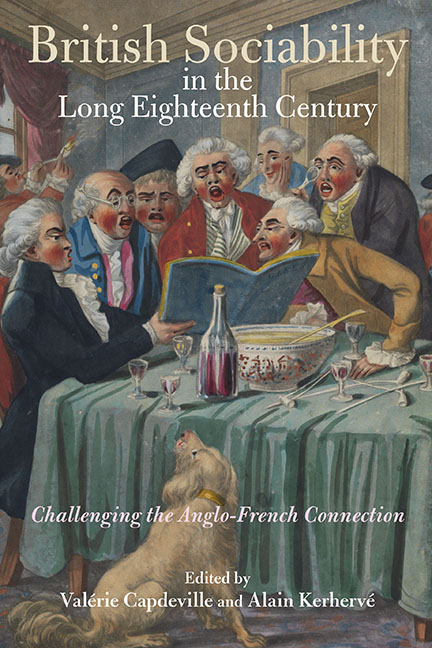Book contents
- Frontmatter
- Contents
- List of illustrations
- List of contributors
- Foreword
- Acknowledgements
- Introduction
- Part 1 Emergence of new political and social practices
- Part 2 Competing models of sociability
- 5 ‘Amateurs’ vs connoisseurs in French and English academies of painting
- 6 Masonic connections and rivalries between France and Britain
- 7 Competing models of sociability: Smollett's repossession of an ailing British body
- 8 A theory of British epistolary sociability?
- 9 Gender and the practices of polite sociability in late eighteenth-century Edinburgh
- Part 3 Paradoxes of British sociability
- Conclusion
- Bibliography
- Index
5 - ‘Amateurs’ vs connoisseurs in French and English academies of painting
from Part 2 - Competing models of sociability
Published online by Cambridge University Press: 18 September 2019
- Frontmatter
- Contents
- List of illustrations
- List of contributors
- Foreword
- Acknowledgements
- Introduction
- Part 1 Emergence of new political and social practices
- Part 2 Competing models of sociability
- 5 ‘Amateurs’ vs connoisseurs in French and English academies of painting
- 6 Masonic connections and rivalries between France and Britain
- 7 Competing models of sociability: Smollett's repossession of an ailing British body
- 8 A theory of British epistolary sociability?
- 9 Gender and the practices of polite sociability in late eighteenth-century Edinburgh
- Part 3 Paradoxes of British sociability
- Conclusion
- Bibliography
- Index
Summary
IN THE HISTORY of western art, academies evolved from professional associations, also known as drawing academies, into institutions embodying cultural and artistic sociability. Under the influence of neoclassicism, academies flourished across Europe in the second half of the eighteenth century before institutional teaching of art began to be questioned at the turn of the century.
Moreover, academic institutions were a frequent object of comparison, whose purpose was to introduce a hierarchy between the three capitals Paris, London and Rome, and it has been established that the Paris academy of painting decisively influenced almost all other academies of art. Most academies included honorary members belonging to the aristocracy or coming from the ranks of connoisseurship. However, as the Paris and London academies were founded 120 years apart, the Académie Royale de Peinture in 1648 and the Royal Academy of Arts in 1768, it might be relevant to assess the limits of the Parisian model when it came to opening up to the non-professional world of connoisseurs, a development truly representative of cultural sociability, as it aimed to bring into contact people from different spheres but with a common purpose: defending the fine arts.
The words used to identify those who had an interest in the arts without necessarily having practical experience differ in French and English writings, and this difference is reflected in the dictionaries: there is no entry for ‘amateur’ in Johnson's Dictionary nor in Chambers’ Cyclopaedia, whereas Pernety's Dictionnaire portatif de peinture, sculpture et gravure includes a lengthy article defining the ‘amateur’ as a lover of the arts with enough enlightened taste to encourage artists and, possibly, engrave their works.
The ‘amateur’ is portrayed here as a knowledgeable collector, perfectly able to advise the artist, while in the same dictionary the ‘connaisseur’ is considered as knowing the rules and precepts necessary to pass a sound judgement on a work of art; many try to pass themselves off as connoisseurs who are in fact ignorant. The ability of the true connoisseur to pass an aesthetic judgement and the existence of frauds are also present in Johnson's quick definition: ‘connoisseur: a judge, a critic, it is often used of a pretended critic’.
- Type
- Chapter
- Information
- British Sociability in the Long Eighteenth CenturyChallenging the Anglo-French Connection, pp. 91 - 108Publisher: Boydell & BrewerPrint publication year: 2019

